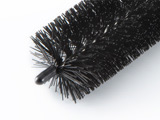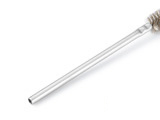Custom Twisted In Wire Brushes - Futch Brush Factory
Tube/Pipe Twisted-In-Wire Brushes
视频播放图标
| Design a Twisted in Wire Brush |

Twisted-in-wire brushes are commonly referred to by our customers as “twisted brushes”, “tube brushes”, “bottle brushes”, “pipe brushes”, “spiral Brushes”, “power or internal cleaning brushes”. They are suitable for both hand-held use and for use in power tools, including drills, drill presses and CNC machining centers.
Twisted-in-wire brushes are made by placing bristle material in between the stem wires and then twisting the stem wires tightly, which secures the filament. With our custom, made-to-order twisted brush capabilities, we can easily adjust the length and diameter of the brush. Combined with our many filament options, the possibilities for your twisted-in-wire brush are practically limitless.
Important: Reversing a twisted-in-wire brush may loosen the stem wire, causing a loss of fill bristles. Always rotate the brush in a clockwise direction when the brush points away from the user. This will tighten the brush construction.
These illustrations depict the three twisted brush stem constructions available to you.

Single-Stem & Single-Spiral - Filaments are twisted between two stem wires with a single layer of filament.

Double-Stem & Single-Spiral - Filaments are twisted between four stem wires with two stem wires on each side. This results in a brush with a much stronger base and potentially greater filament density.

Double-Stem & Double-Spiral - Filaments are twisted between four stem wires with two layers of bristles. Each layer is perpendicular to the other with a single stem wire in each quadrant. This results in a brush with the highest filament density and highest strength.
Twisted Brush Tip Style
Brush tip options depend on the stem construction and fill material being used. Illustrated below are the most common brush tip styles:
Continuous End
Cut End
Loop Tip
Plastic Tip
Tied Tuft Tip
Rosebud Tip
Pointed Stee End Cap
Special Turned End








Note: wire fill material is not recommended for a turned tuft brush tip.
Brushes Twisted Brush End Type / Attachments
The brush end options depend on the stem construction and brush application. Our twisted brushes can be designed for either hand use or power-driven applications that require more aggressive cleaning. Either style can be made in range of diameters and with a variety of materials including nylon, carbon steel, stainless steel and brass. Shown below are the most popular brush end styles:
Cut End
Loop End
Pipe Nipple End
Tube End
Oval Loop
Dipped End
Threaded End
Threaded Wire End
Wooden Handle
Wooden Handle
Plumbing Tool End
Special Plastic Handle
Plastic Tube End
Flared Wire End














Note: Power-driven brushes should be firmly chucked into a suitable holder at all times. Always wear eye protection and follow safety guidelines.
Important: Reversing a twisted-in-wire brush may loosen the stem wire, causing a loss of fill bristles. Always rotate the brush in a clockwise direction when the brush points away from the user. This will tighten the brush construction.
Brush Diameter
There is a large variation of brush diameters available. However, the brush diameter will depend heavily on the selected stem wire construction as well as the filament being used. A shorter trim-length or larger bristle diameter will stiffen the brush.
Fill Material and Length of Twisted Brush Part
The fill material selection is determined by your particular application as well as the size of your brush. Standard fillings for twisted-in-wire brushes include synthetics, natural fibers and wires.
Stem Material, Stem Gauge Twisted Brush
Stem wire materials used in twisted-in-wire brushes are galvanized steel, stainless steel and in some cases, brass or aluminum wire. The stem gauge is the diameter of the stem wire that is used to twist the filament into the brush.
Gauge#
Wire Diameter
Single Stem Twisted Diameter
Double Stem Twisted Diameter
1
0.283
0.525
0.737
2
0.263
0.486
0.685
3
0.244
0.446
0.634
4
0.225
0.413
0.586
5
0.207
0.379
0.538
6
0.192
0.553
0.499
7
0.177
0.325
0.46
8
0.162
0.298
0.421
9
0.148
0.273
0.385
10
0.135
0.248
0.351
11
0.121
0.221
0.313
12
0.106
0.194
0.274
13
0.092
0.168
0.238
14
0.08
0.147
0.208
15
0.072
0.132
0.187
16
0.063
0.115
0.163
17
0.054
0.099
0.14
18
0.048
0.087
0.124
19
0.041
0.075
0.107
20
0.035
0.064
0.095
21
0.032
0.058
0.082
22
0.029
0.053
0.074
23
0.026
0.046
0.067
24
0.023
0.041
0.06
25
0.02
0.037
0.053
26
0.018
0.033
0.047
28
0.016
30
0.014
32
0.013
33
0.012
34
0.01
35
0.01
36
0.009
38
0.008
Common Applications of Twisted Brushes
Long-lasting industrial tube brushes can be used in manual cleaning or be adapted for use with power tools. Brush style, shape and fill materials can be customized to ensuring optimal brush surface contact and polish effectiveness. Common twisted tube brush users include industrial users, electronic manufacturers, scientists and product designers. But bottle brushes are perfect for cleaning the interior surfaces of all tubes, internal threads or drilled holes in nearly any industry.
General applications include cleaning, polishing, reaming, finishing or removing debris or burrs from internal non-metallic and metallic surfaces. Specific applications for twisted-in-wire brushes include:
• Cleaning internal tubing, piping and cylinders
• De-burring machined and threaded holes in castings, tanks and machined parts
• Abrasive brushes for tough slag removal
• Cleaning medical devices and equipment
• Cleaning laboratory equipment and beakers
• Cleaning hydraulic fittings and nozzles
• Cleaning shotguns, pistols and rifles
• Whisper light brushes for clean electronic and computer components
• Lightning dissipation
• Removing gases during vacuum distillation process
• Removing water bubbles in air fluid control
• Cleaning refrigerator coils
• Cleaning valve guidesCleaning automotive and aircraft parts
• Cleaning automotive and aircraft parts
